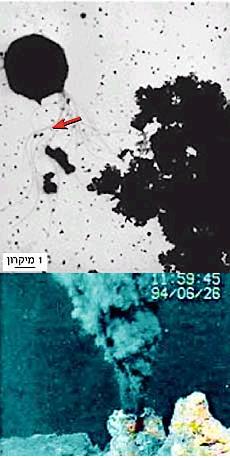The bacterium "resistance" 121 probably developed with the beginning of life on Earth; Understanding its mechanisms will make it possible to develop heat resistance materials
Lior Kodner, Haaretz and Walla News!

"Resistance" bacterium 121 (in the upper picture) and "black smoker" (in the lower picture) in which the bacterium grows. The bacteria may even enjoy the heat
Direct link to this page: https://www.hayadan.org.il/strain121.html
Another record has now been added to the list of records related to heat and water that were broken last summer. This time it is not about the record temperature in another city in Europe, nor a world record in swimming - but about the heat resistance of a living being. The new record, crowned in the scientific journal Science, is a recently discovered bacterium named "Resistance Strain "121 (""121"). The bacterium is found in the depths of the Pacific Ocean, at high temperatures between 85 and 121 degrees Celsius.
To extract the bacterium from the depths of the sea, in the area of the Juan de Fuca ridge, the researchers used a submarine operated by remote control in order to reach a depth of 2.4 kilometers where it grew. The living conditions at the bottom forced the bacterium to develop an extraordinary resistance to heat. His nickname was given to him after, in experiments conducted by the researchers from the University of Massachusetts and Washington, it became clear that he is able to function at a temperature of up to 121 degrees. In fact, Durability 121 may even benefit from the heat. According to the journal article, within 24 hours of being placed at this temperature, its population doubled. At slightly higher temperatures, the bacteria managed to survive - but stopped functioning properly.
The record holder until today was another bacterium: the "Pyrolobos fumari" - but it is not able to handle such a high temperature. In the experiment it became clear that after an hour in the heat of 121 degrees, only 1% of the Pyrolobus fumari cells were intact, and none of them showed signs of life.
"Resistance" 121 belongs to the archaea family - single-celled organisms from the bacteria family, which are able to survive in extreme conditions. "Heat-resistant bacteria have been known for many years," explains Prof. Hillel Berkoviar from the Institute of Microbiology at the Hebrew University of Jerusalem. According to him, "in the past, scientists found bacteria that are resistant to a temperature of 60 degrees, then 100 degrees and even more."
Not all bacteria are immune to such high heat, and this is what the pasteurization process is based on - a method of killing bacteria using heat, invented at the end of the 19th century by the French researcher Louis Pasteur. The process, based on heating milk for about half an hour at a temperature of 60 degrees, is designed to kill the bacteria in the milk and its products with almost no change in their nutritional value or taste.
The underwater landscape in the living environment of "Resistance" 121 mainly includes openings called "Black Smokers". These rise from the bottom, as three- and four-story chimneys, and emit a blackening mixture containing iron and sulfur compounds. For the animals, this is a suffocating, boiling and poisonous inferno, but regarding "durability" 121 this is a particularly good arrangement. Throughout evolution, the bacterium has developed a special way of life: it uses iron, in the same way that the animals we know consume oxygen. The iron allows the bacterium to burn its food to produce energy.
Chemically, the bacterium's respiration process is based on adding an electron to iron - in this way the mineral "magnetite" is formed. The existence of massive deposits of magnetite in the deep ocean, and the abundance of iron that existed on Earth before life began, led researchers to the conclusion that "Resistance" 121 is one of the first forms of life that evolved on our planet.
According to Prof. Bercoviar, investigating the ways in which the bacterium survives in high heat can help the industry. "Heat is a critical element for life, but the bacterium has developed a mechanism that allows it to survive in extreme conditions. We need to identify the mechanisms that work in bacteria, so for example we can develop a method that will prevent sugar from turning into caramel at 80 degrees."
For news at the BBC
A concentration of life science experts
https://www.hayadan.org.il/BuildaGate4/general2/data_card.php?Cat=~~~608471707~~~152&SiteName=hayadan

One response
The truth is that in the literary sources there is an animal created from a source of fire that has been active for 7 years, the creature is called a salamander, I wonder if and when science will discover this animal and what will they call durability then